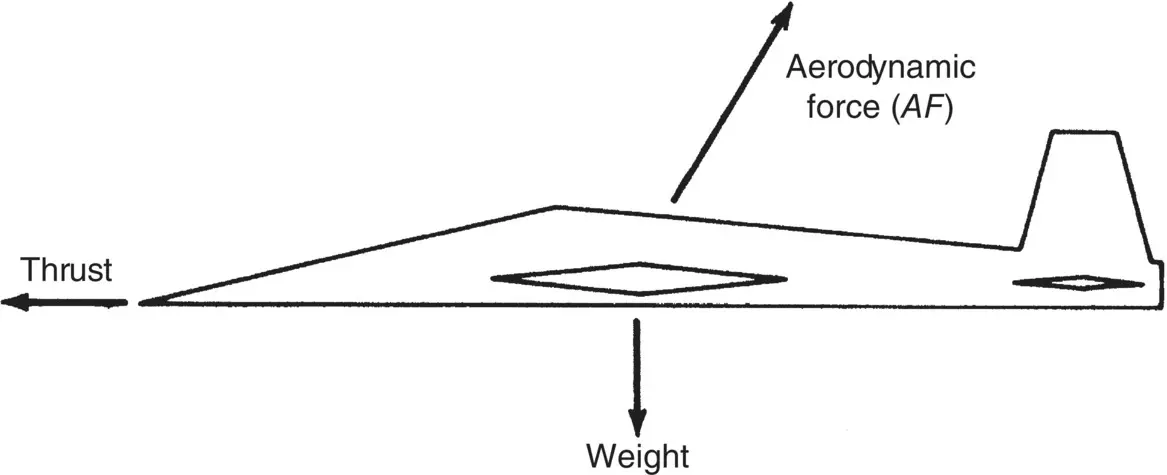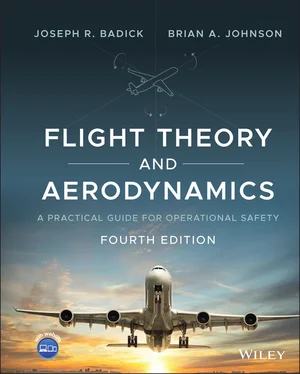We will start with the concepts of work, energy, power, and friction, and then build upon them as we move forward in future chapters.
Because the metric system of measurement has not yet been widely accepted in the United States, the English system of measurement is used in this book. The fundamental units are
| Force |
Pounds (lb) |
| Distance |
Feet (ft) |
| Time |
Seconds (s) |
From the fundamental units, other quantities can be derived:
| Velocity (distance/time) |
ft/s (fps) |
| Area (distance squared) |
square ft (ft 2) |
| Pressure (force/unit area) |
lb/ft 2(psf) |
| Acceleration (rate of change in velocity) |
ft/s/s (fps 2) |
Aircraft measure airspeed in knots (nautical miles per hour) or in Mach number (the ratio of true airspeed to the speed of sound). Rates of climb and descent are measured in feet per minute, so quantities other than those above are used in some cases. Some useful conversion factors are listed below:
| Multiply |
by |
to get |
| knots (kts.) |
1.69 |
feet per second (fps) |
| fps |
0.5925 |
kts. |
| miles per hour (mph) |
1.47 |
fps |
| fps |
0.6818 |
mph |
| mph |
0.8690 |
kts. |
| kts. |
1.15 |
mph |
| nautical miles (nm) |
6076 |
feet (ft) |
| nm |
1.15 |
statute miles (sm) |
| sm |
0.869 |
nm |
| kts. |
101.3 |
feet per minute (fpm) |
Convert 110 kts. to fps: 110 kts. × 1.69 = 185.9 fps
Convert 50 kts. to fpm: 50 kts. × 101.3 = 5,065 fpm
Convert 450 fps to kts. = 450 fps × 0.5925 = 267 kts.
Convert 25 sm to nm: 25 sm × 0.869 = 21.7 nm
An airplane flight manual (AFM) states a given aircraft should be rotated at 65 kts. indicated airspeed (IAS), yet the pilot misinterprets the airspeed indicator and rotates at 65 mph (IAS).
Does the aircraft rotate at a faster or slower airspeed than the manufacturer recommends? What are the implications?
A force is a push or a pull tending to change the state of motion of a body. A resolution of the typical forces acting on an aircraft in steady flight is shown in Figure 1.1, while Figure 1.2shows the four separate components of aerodynamic forces during straight‐and‐level, unaccelerated flight. The component that is 90° to the flight path and acts toward the top of the airplane is called lift . The component that is parallel to the flight path and acts toward the rear of the airplane is called drag ; while the opposing forward force is thrust and is usually created by the engine. Weight opposes lift and as we will see is a function of the mass of the aircraft and gravity.
The sum of the opposing forces is always zero in steady flight, but this does not mean the four forces are equal. In future chapters of this textbook, we will further demonstrate the following statement regarding forces acting on an airplane in steady flight: The sum of all upward component of forces equals the sum of all downward components of forces, and the sum of all forward components of forces equals the sum of all backward components of forces.

Figure 1.1 Forces on an airplane in steady flight.

Figure 1.2 Resolved forces on an airplane in steady flight.
Source: U.S. Department of Transportation Federal Aviation Administration (2008a).
Mass is a measure of the amount of material contained in a body, usually measured in kilograms; we will use slugs as the unit in this textbook. Weight , on the other hand, is a force caused by the gravitational attraction of the earth ( g = 32.2 ft/s 2), moon, sun, or other heavenly bodies. Weight will vary depending on where the body is located in space (specifically, how far from the source of gravitational attraction), but mass will not vary with position.
(1.1) 
Rearranging gives

This mass unit is called the slug .
Calculate the mass of an aircraft that weighs 2576 lb.

SCALAR AND VECTOR QUANTITIES
A quantity that has size or magnitude only is called a scalar quantity. The quantities of mass, time, and temperature are examples of scalar quantities. A quantity that has both magnitude and direction is called a vector quantity. Forces, accelerations, and velocities are examples of vector quantities. Speed is a scalar, but if we consider the direction of the speed, then it is a vector quantity called velocity . If we say an aircraft traveled 100 nm, the distance is a scalar, but if we say an aircraft traveled 100 nm on a heading of 360°, the distance is a vector quantity.
Scalar quantities can be added (or subtracted) by simple arithmetic. For example, if you have 5 gallons of gas in your car’s tank and you stop at a gas station and top off your tank with 9 gallons more, your tank now holds 14 gallons.
Vector addition is more complicated than scalar addition. Vector quantities are conveniently shown by arrows. The length of the arrow represents the magnitude of the quantity, and the orientation of the arrow represents the directional property of the quantity. For example, if we consider the top of this page as representing north and we want to show the velocity of an aircraft flying east at an airspeed of 300 kts., the velocity vector is as shown in Figure 1.3. If there is a 30‐kts. wind from the north, the wind vector is as shown in Figure 1.4.
To find the aircraft’s flight path, groundspeed, and drift angle, we add these two vectors as follows. Place the tail of the wind vector at the head of the arrow of the aircraft vector and draw a straight line from the tail of the aircraft vector to the head of the arrow of the wind vector. This resultant vector represents the path of the aircraft over the ground. The length of the resultant vector represents the groundspeed, and the angle between the aircraft vector and the resultant vector is the drift angle ( Figure 1.5).

Figure 1.3 Vector of an eastbound aircraft.
Читать дальше


















